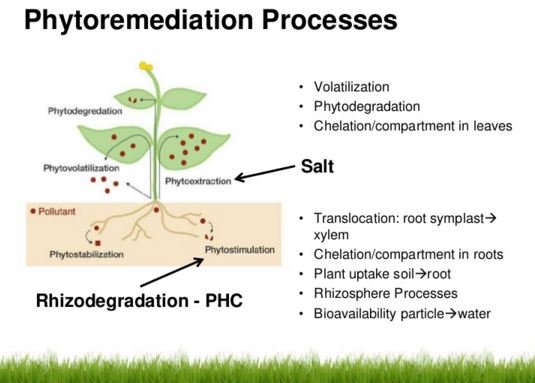Phytoremediation
What is phytoremediation?
Phytoremediation term is derived from two generic terms including ‘phyto’ means plant and ‘remediation’ means impeding environmental damage. Phytoremediation is an assembly of technologies, using a group of plants for remediation of soils, water, sludge which get sediment with different types inorganic and organic contaminants.
By using phytoremediation technology, efficiently using the plants for removal, detoxification or immovable contaminants shifted to growth matrix by utilizing chemical and biological process or physical activities or sometimes a combination of both. The plants used for phytoremediation technology selectively metabolize or absorbed contaminates from the soil, water or other growth matrix.

Phytoremediation is a time specific technology, as this requires sufficient time for plant growth, then binding process for facilitating the immobilization and degrading the contaminants. For continuous processing the phytoremediation require subsequent harvesting, processing and disposing.
The evaluation of plants occurs due to genetic alterations which efficiently able to manage the collected pollutants in the surrounding environment.
Phytoremediation method used for denominating the sites which are contaminated by metals, explosives, hydrocarbons, pesticides, crude oil, solvents, polyaromatic and landfill leaches. River basin management can also do with hydraulic control of contaminants which is part of phytoremediation.
Plants used in phytoremediation
- Alfalfa
- Arrowroot
- Alpine Bluegrass
- Blue-green Algae
- Bermuda Grass
- Duck Weed
- Hybrid Poplar Trees
- Rye Grass
- Sudan Grass
- Yellow or White Water Lillies
Phytoremediation Process
Different mechanisms are used in phytoremediation, these are described in below:
Rhizosphere biodegradation
In this process biodegradation is conducted through supplying nutrients to microorganisms present in the soil. The plant roots are utilizing for supplying the nutrients for enhancing biodegradation.
Phyto-stabilization
The plant immobilize contaminants are chemically modified, rather than degrading them.
Phyto-accumulation or phyto-extraction
By absorption method plants roots are extracted contaminates from the soil along with water and other nutrients. These contaminate accumulated in the aerial parts of the plant and later they are recycled or disposed of as perilous substance.
Different metals are mainly disposed off in this process. Depending upon the bio-availabity, extraction process depends. Like cadmium, zinc, nickel, arsenic, copper and selenium are readily bioavailable and can be extracted easily, but lead, chromium, radio-cesium 137 and uranium are not extracted easily, because of their bioavailability level are less.
To improve their bioavailability, chelating agents are used for lead and ammonium nitrate and citric acid used for radio-cesium 137 and uranium in the soil.
Rhizofiltration
In this process hydrophonic technology is utilized for treating water streams. The mechanism of this technique is quite similar with phyto-accumulation.
The difference is the plants are cultivated in the greenhouse where their roots are growing in the water. The ground water treatment can be done in this method.
The ground water is utilised for irrigation of such plants and by using hydrophonic technology in the artificial soil medium. Roots continuously absorb the contaminants and become saturated. Then these plants collected and disposed of.
Phyto-volatilization
In this technique, plants absorbed water soluble organic contaminants and through vaporization process contaminants are released into the air.
Phyto-degradation
Contaminants are decomposed inside the plant tissue and divested them.
Hydraulic Control
In this process used trees are working as natural pumps and ultimately impeding the damage by controlling ground water.
Applicability
Phytoremediation applicability is beneficial for eliminating, detoxification of metal contaminants, pesticides, volatile and semi volatile organic components, explosive substances. Further research is continuing for remediation of percolates that can contaminant surface and ground water. For radioactive components, adding some chelating agents can provide better results for phytoremediation. In large scale project, the process may provide better result.
Scope for development of the phytoremediation
The application of phytoremediation, is mainly limited in small scale projects, very few big projects are utilizing phytoremediation. For potential application more practical research is needed in future.
Limitations and Concerns
There are still many questions arises regarding affectivity of the phytoremediation process. The product produced during degradation may be accumulated in the animals via food materials obtained by plants or it may be again stored in ground water, as atomospheric layer stored the degraded materials for short vial and via rain water it may again stored in ground water. The toxic effect remediation of contaminants through the phytoremediation process is still has many concerns.
The research need to provide evidence that leaves fall down during autumn do not produce any contamination in the soil or fire wood also not release any gas which causes harmful effect to the environment.
Clearance of collecting plants can be difficult, if the amount of heavy metals is high.
The potentiality of the phytoremediation has some limitations, as the tree or plants roots how much extended in the deep and absorb contaminants from there is doubtful. The effectiveness mainly limits to surface or shallow soils and stream water.
In case of ground water treatment, pumping method is needed to collect the water, which is also added cost. In case of deep penetration, it is suggested that the usages of tree are more effective than plants, as the roots of trees are extended much than the plant.
The effectiveness of phytoremediation is seasonal; due to plant development is mainly season based. A large area is required for cultivation of plants or tree used in phytoremediation.
References
- http://www.unep.or.jp/Ietc/Publications/Freshwater/FMS2/1.asp
- http://www.cpeo.org/techtree/ttdescript/phytrem.htm
- https://clu-in.org/
- http://www.nature.com/scitable/knowledge/library/phytoremediation-17359669
- http://www.rpi.edu/dept/chem-eng/Biotech-Environ/MISC/phytorem.html
